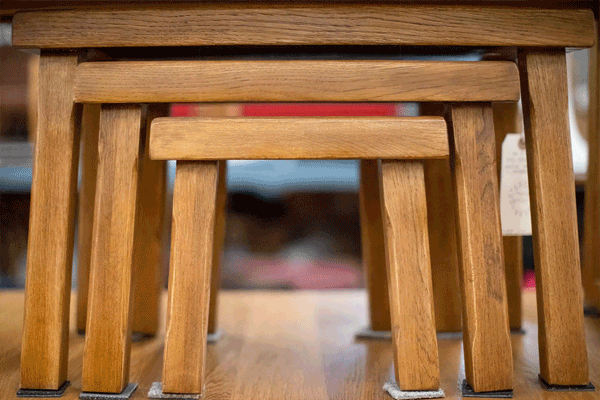Consumers Want Furniture They Can Live With
- Share via
HIGH POINT, N.C. — The concept is simple: furniture that’s easy to live with. But how do you convince buyers your stylish new collection is more than just another pretty face?
That’s the question manufacturers struggled with for the International Home Furnishings Market, held here recently. The twice-yearly wholesale market introduces styles that will be making their way to stores in about six months.
To woo consumers who have been skittish about buying furniture recently, companies made sofas smaller--the better to fit into smaller living rooms--and enlarged coffee tables--the better to eat dinner off in front of the television. (One of the market’s hottest styles in coffee tables was the multi-functional tea table, 24 inches high instead of 18.)
They put tables and cabinets on casters and gave upholstered chairs a push-back feature as on a recliner. Armoires had built-in tie racks; desk chairs folded down to fit in a home-office unit.
Collections in many showrooms featured more occasional pieces than ever--furniture with several uses, like nesting tables and benches, that can be moved easily to change the look of a room.
For inspiration, designers used the easy-to-live-with clean lines and casual feel of the English Arts and Crafts movement and its American counterpart, Mission. Such adaptations were everywhere at this spring’s market. Henredon, a high-end manufacturer, updated its Arts and Crafts-inspired pieces with Asian accents. Henredon’s version of the classic William Morris chair, for instance, looks remarkably at home--and a bit more exotic than the original--in rattan.
Not everything was clean-lined. For those who want richness, ornate carving and ornamentation, Lane introduced the major new licensing program of the spring market, the 80-piece Hearst Castle Collection. This included reproductions, adaptations and inspirations from publisher William Randolph Hearst’s Mediterranean Revival mansion at San Simeon. Even this, though, was sold as “livable luxury.”
In Lane’s showroom, a catsup bottle and a mustard jar were prominently on display, sitting on the adaptation of a 17th century English refectory table--just as they used to be when Hearst visited the mansion he called his ranch. The condiments were there to remind buyers that in spite of all the opulent twist carvings, walnut veneers and elegant fabrics, these furnishings were just as down-home as a pine rocker with a gingham-covered seat cushion.
Other designers responded to consumers’ desire for usefulness combined with ornament by coming out with what they called “southern European” styles, not to be confused with the dreaded Mediterranean of the late 1960s and early ‘70s.
“This is pretty. That was ugly,” said Wayne Burris of Pulaski Furniture, which introduced a new collection, Corsica, that came perilously close to being the M-word. “Before, it was how many carvings and hinges you could put on before they fell off.”
The new, not-quite-Mediterranean styles brought out by several manufacturers are as massive in scale as their predecessors, but often have lighter finishes, more restrained carvings and light distressing that gives the furniture a well-used (and therefore more livable) look. The most long-lasting easy-to-live-with look of all, country, seemed finally to have run its course.
There were other notable trends at this spring’s market:
*
Seeing red: The big color story was not the much ballyhooed techno-brights.
Instead, red was everywhere. Not a bright red or a clear red, but soft, subdued, earthy shades such as persimmon, paprika and mulberry. These reds function as a neutral, and manufacturers paired them with just about everything.
Bench press: At the past few markets, ottomans were big news. Now benches have become the occasional piece of note. They can be used in front of a sofa or at the foot of the bed. They can sit in a foyer until they are needed for extra seating. And these benches often have more style in one curved leg than massive pieces have in their whole frames.
Global warming: Imports and ethnic accents continue to be important. Maitland-Smith’s huge London Explorers Club introduction of occasional furniture and accessories from all over the world got the most attention. But in many showrooms there were collections inspired by places like the Dutch West Indies and furniture like sofas made of banana bark or raffia chairs.
Mixed media: Those were the buzzwords for styles that combined several materials. But the emphasis often was on making the furniture more affordable. Several companies, for instance, combined leather and fabric to keep the price down.
Leather looks: Leather was as hot as ever, but it came in new, more durable finishes, new dressmaker trims and even a faux blue denim look with jeans stitching (from Highland House).
It’s a boy: Humidors in all shapes, sizes and prices were everywhere for storing those oh-so-trendy cigars. In spite of all the talk last market of a new femininity in furniture design, menswear motifs were prominent, masculine-looking nailhead trim showed up on many upholstered pieces, and Ralph Lauren introduced its rugged for-men-only New Zealand collection.
Just relax: When recliners and other motion furniture first came out, it was enough that the head went back and the feet came up. Now recliners do everything but feed the cat. Not only did this market’s models have heat and speaker phones, or at the very least phone jacks, but Panasonic also introduced its Great Escape lounger, which “simulates the movements of a real shiatsu massage therapist.”
The princess and the pea: Maybe it’s the graying of America, but mattresses were news at High Point this spring. Kingsdown’s $5,000 mattress set is now the company’s bestseller. (Can any mattress really be worth $5,000?)
And the winner is . . . : The award for this market’s trendiest piece goes to Flexsteel, a century-old manufacturer of traditional furniture. The company introduced a Mission-inspired recliner with straight lines and vertical slats. It was covered in leather and had a golfer-motif print.


